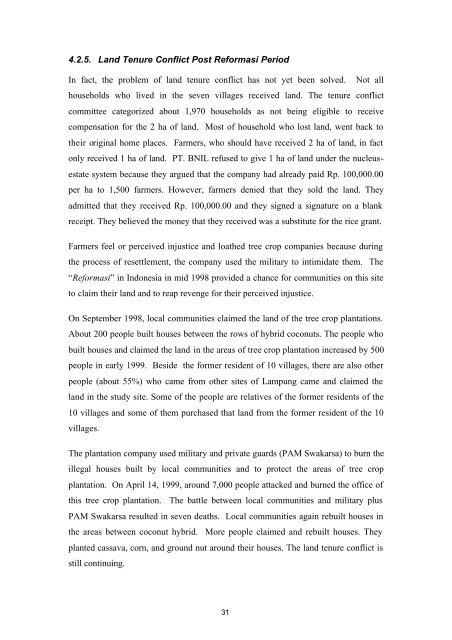English - Center for International Forestry Research
English - Center for International Forestry Research
English - Center for International Forestry Research
You also want an ePaper? Increase the reach of your titles
YUMPU automatically turns print PDFs into web optimized ePapers that Google loves.
4.2.5. Land Tenure Conflict Post Re<strong>for</strong>masi Period<br />
In fact, the problem of land tenure conflict has not yet been solved. Not all<br />
households who lived in the seven villages received land. The tenure conflict<br />
committee categorized about 1,970 households as not being eligible to receive<br />
compensation <strong>for</strong> the 2 ha of land. Most of household who lost land, went back to<br />
their original home places. Farmers, who should have received 2 ha of land, in fact<br />
only received 1 ha of land. PT. BNIL refused to give 1 ha of land under the nucleusestate<br />
system because they argued that the company had already paid Rp. 100,000.00<br />
per ha to 1,500 farmers. However, farmers denied that they sold the land. They<br />
admitted that they received Rp. 100,000.00 and they signed a signature on a blank<br />
receipt. They believed the money that they received was a substitute <strong>for</strong> the rice grant.<br />
Farmers feel or perceived injustice and loathed tree crop companies because during<br />
the process of resettlement, the company used the military to intimidate them. The<br />
“Re<strong>for</strong>masi” in Indonesia in mid 1998 provided a chance <strong>for</strong> communities on this site<br />
to claim their land and to reap revenge <strong>for</strong> their perceived injustice.<br />
On September 1998, local communities claimed the land of the tree crop plantations.<br />
About 200 people built houses between the rows of hybrid coconuts. The people who<br />
built houses and claimed the land in the areas of tree crop plantation increased by 500<br />
people in early 1999. Beside the <strong>for</strong>mer resident of 10 villages, there are also other<br />
people (about 55%) who came from other sites of Lampung came and claimed the<br />
land in the study site. Some of the people are relatives of the <strong>for</strong>mer residents of the<br />
10 villages and some of them purchased that land from the <strong>for</strong>mer resident of the 10<br />
villages.<br />
The plantation company used military and private guards (PAM Swakarsa) to burn the<br />
illegal houses built by local communities and to protect the areas of tree crop<br />
plantation. On April 14, 1999, around 7,000 people attacked and burned the office of<br />
this tree crop plantation. The battle between local communities and military plus<br />
PAM Swakarsa resulted in seven deaths. Local communities again rebuilt houses in<br />
the areas between coconut hybrid. More people claimed and rebuilt houses. They<br />
planted cassava, corn, and ground nut around their houses. The land tenure conflict is<br />
still continuing.<br />
31
















